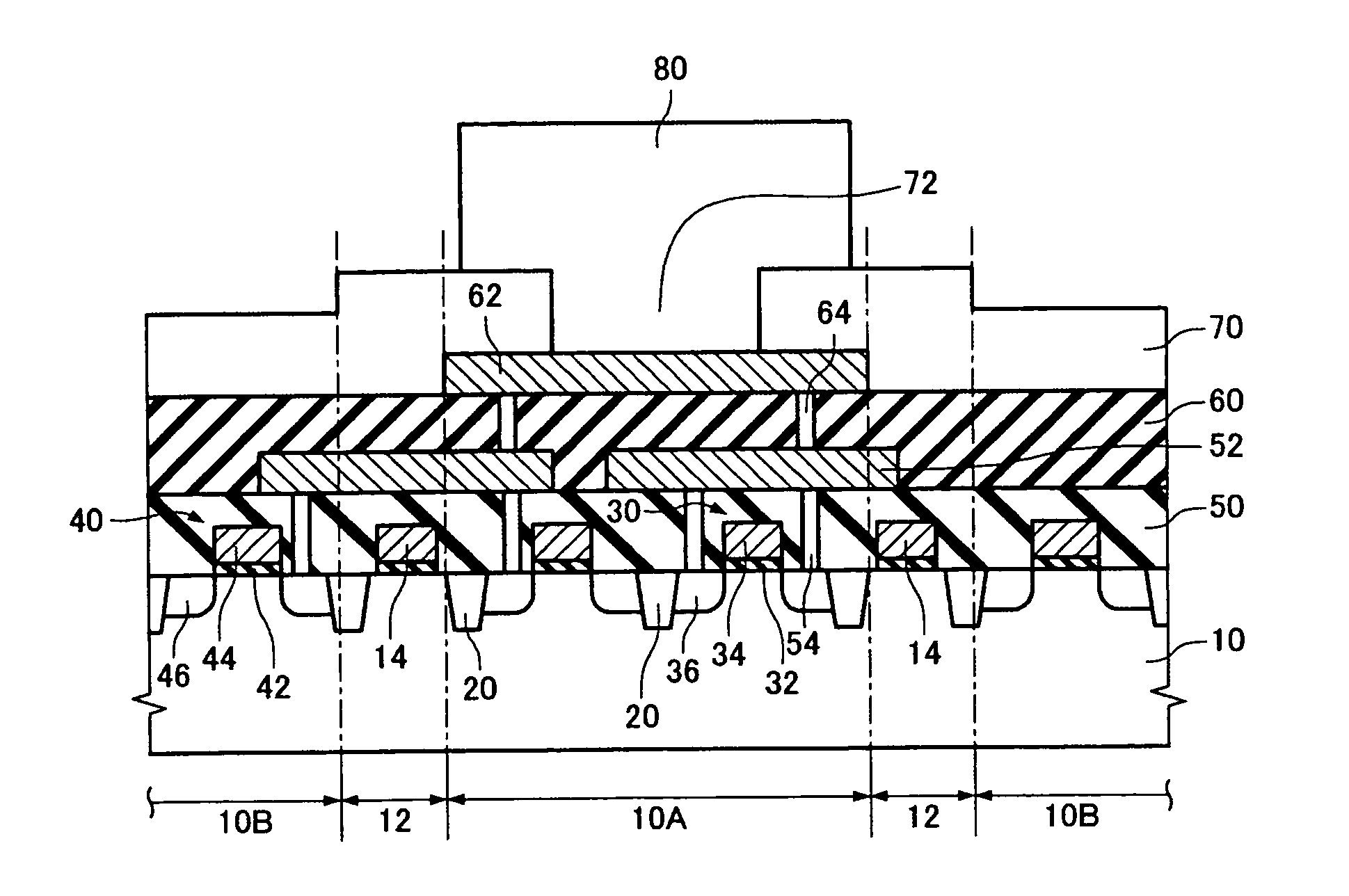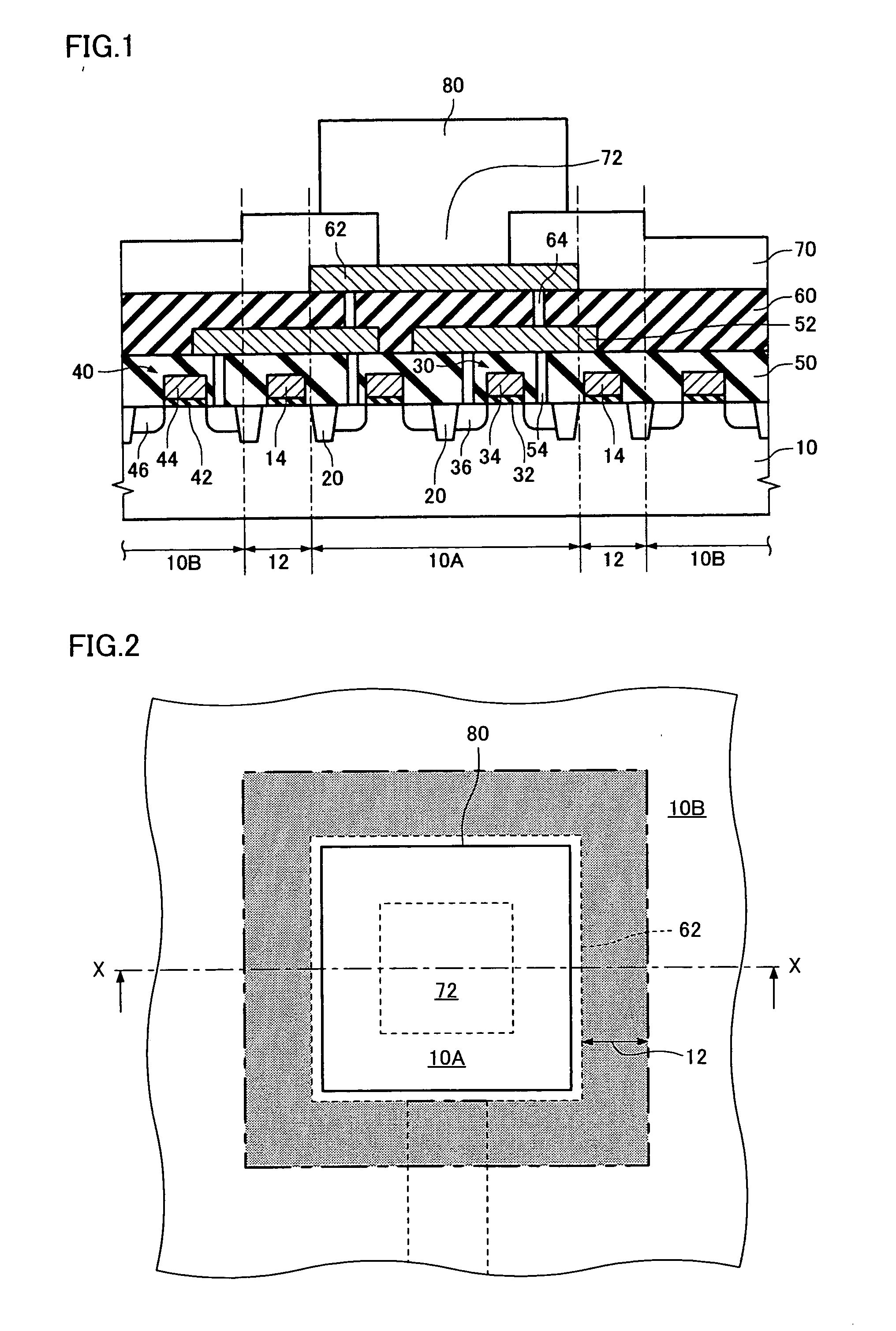Semiconductor device
a technology of semiconductor elements and devices, applied in semiconductor devices, semiconductor/solid-state device details, electrical apparatus, etc., can solve problems such as impairment of characteristics of semiconductor elements such as mis transistors
- Summary
- Abstract
- Description
- Claims
- Application Information
AI Technical Summary
Benefits of technology
Problems solved by technology
Method used
Image
Examples
first embodiment
1. First Embodiment
[0068]FIG. 1 is a cross-sectional view schematically showing a semiconductor device according to a first embodiment of the invention, and FIG. 2 is a plan view schematically showing the relationship between the shape of an electrode pad and a forbidden region in the semiconductor device according to the first embodiment. FIG. 1 shows the cross section along the line X-X shown in FIG. 2.
[0069] As shown in FIG. 1, the semiconductor device according to the first embodiment includes a semiconductor layer 10. As the semiconductor layer 10, a single crystal silicon substrate, a silicon on insulator (SOI) substrate in which a semiconductor layer is formed on an insulating layer, the semiconductor layer being a silicon layer, a germanium layer, or a silicon germanium layer, or the like may be used.
[0070] An isolation insulating layer 20 is formed in the semiconductor layer 10. The isolation insulating layer 20 may be formed by a shallow trench isolation (STI) method, a ...
second embodiment
2. Second Embodiment
[0085] A second embodiment of the invention is described below with reference to FIGS. 3 and 4.
[0086]FIG. 3 is a cross-sectional view schematically showing a semiconductor device according to the second embodiment, and FIG. 4 is a plan view schematically showing the relationship between an electrode pad and a forbidden region in the semiconductor device according to the second embodiment. FIG. 3 shows the cross section along the line X-X shown in FIG. 4. Note that members substantially the same as the members in the first embodiment are assigned the same symbols. Detailed description of these members is omitted.
[0087] The semiconductor device according to the second embodiment differs from the semiconductor device according to the first embodiment in that the forbidden region 12 is specified taking into consideration the bump 80 in addition to the electrode pad 62 described in the first embodiment. In the second embodiment, the forbidden region 12 includes a fi...
third embodiment
3. Third Embodiment
[0095] A third embodiment of the invention is described below with reference to FIG. 5. FIG. 5 is a cross-sectional view schematically showing a semiconductor device according to the third embodiment. The semiconductor device according to the third embodiment differs from the semiconductor devices according to the first and second embodiments in that a specific semiconductor element is formed in the forbidden region 12. The following description merely illustrates the difference from the semiconductor device according to the first embodiment. Note that members substantially the same as the members of the semiconductor device according to the first embodiment are assigned the same symbols. Detailed description of these members is omitted.
[0096] As shown in FIG. 5, the semiconductor device according to the third embodiment includes the active region 10A and the forbidden region 12 provided around the active region 10A. In the semiconductor device according to the t...
PUM
 Login to View More
Login to View More Abstract
Description
Claims
Application Information
 Login to View More
Login to View More - R&D
- Intellectual Property
- Life Sciences
- Materials
- Tech Scout
- Unparalleled Data Quality
- Higher Quality Content
- 60% Fewer Hallucinations
Browse by: Latest US Patents, China's latest patents, Technical Efficacy Thesaurus, Application Domain, Technology Topic, Popular Technical Reports.
© 2025 PatSnap. All rights reserved.Legal|Privacy policy|Modern Slavery Act Transparency Statement|Sitemap|About US| Contact US: help@patsnap.com



